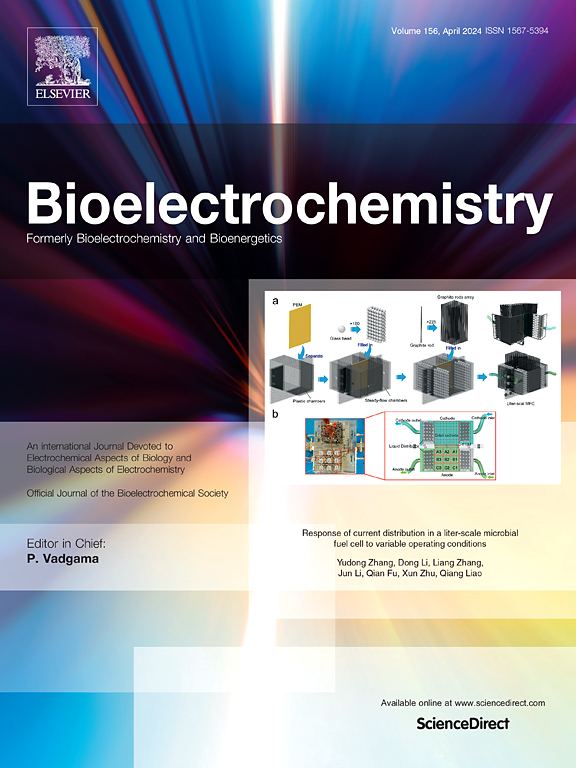Development of a model to describe the performance of electromethanosynthesis in two microbial electrolysis cells with different biocathode sizes
IF 4.8
2区 化学
Q1 BIOCHEMISTRY & MOLECULAR BIOLOGY
引用次数: 0
Abstract
Electromethanosynthesis in a Microbial Electrolysis Cell facilitates CH4 production through enhanced reaction kinetics and efficient CO2/CH4 separation, while concurrently facilitating wastewater treatment. Two MECs which differed in the biocathode projected surface area (1.25 and 0.25 m2) were constructed and operated. The results demonstrated that increasing the electrode size led to increased CH4 production and improved MEC efficiency. A mathematical model was developed to describe the two MECs in the COMSOL Multiphysics framework, which simulates the growth of six microbial populations, using Butler-Volmer-Monod kinetics, taking into account the impact of the overpotentials. The model captured the effect of the developed overpotentials on substrate consumption and current production and the simulations showed good agreement with the measured variables in terms of reaction rates, leading to a deviation of 2.5 % for organic content removal and < 1 % for electromethanosynthesis. The validation of the model, accounting for varying biocathode sizes, accurately predicted the CH4 production under all different conditions employed and the highest deviation was 10 %. The developed model provides the foundation for understanding the dynamics of substrate availability, diffusion of species, electrochemical reactions and microbial populations, across multiple chemical pathways, while establishing the framework for predicting the significance of reactor design for efficient electromethanosynthesis.

建立一个模型来描述具有不同生物阴极尺寸的两种微生物电解池的电甲醇合成性能
微生物电解池中的电甲烷合成通过增强反应动力学和有效的CO2/CH4分离促进了CH4的产生,同时促进了废水处理。构建并运行了两个不同生物阴极投影表面积(1.25和0.25 m2)的mec。结果表明,增加电极尺寸可以增加CH4的产量,提高MEC效率。在COMSOL Multiphysics框架中建立了一个数学模型来描述这两个mec,该模型使用Butler-Volmer-Monod动力学模拟了六种微生物种群的生长,并考虑了过电位的影响。该模型捕获了发展过电位对底物消耗和电流产生的影响,模拟结果与反应速率方面的测量变量吻合良好,导致有机含量去除和<的偏差为2.5%;1%用于电甲烷合成。考虑到不同的生物阴极尺寸,模型的验证准确地预测了所有不同条件下的CH4产量,最高偏差为10%。所开发的模型为理解多种化学途径中底物有效性、物种扩散、电化学反应和微生物种群的动力学提供了基础,同时为预测反应器设计对高效甲烷电合成的重要性建立了框架。
本文章由计算机程序翻译,如有差异,请以英文原文为准。
求助全文
约1分钟内获得全文
求助全文
来源期刊

Bioelectrochemistry
生物-电化学
CiteScore
9.10
自引率
6.00%
发文量
238
审稿时长
38 days
期刊介绍:
An International Journal Devoted to Electrochemical Aspects of Biology and Biological Aspects of Electrochemistry
Bioelectrochemistry is an international journal devoted to electrochemical principles in biology and biological aspects of electrochemistry. It publishes experimental and theoretical papers dealing with the electrochemical aspects of:
• Electrified interfaces (electric double layers, adsorption, electron transfer, protein electrochemistry, basic principles of biosensors, biosensor interfaces and bio-nanosensor design and construction.
• Electric and magnetic field effects (field-dependent processes, field interactions with molecules, intramolecular field effects, sensory systems for electric and magnetic fields, molecular and cellular mechanisms)
• Bioenergetics and signal transduction (energy conversion, photosynthetic and visual membranes)
• Biomembranes and model membranes (thermodynamics and mechanics, membrane transport, electroporation, fusion and insertion)
• Electrochemical applications in medicine and biotechnology (drug delivery and gene transfer to cells and tissues, iontophoresis, skin electroporation, injury and repair).
• Organization and use of arrays in-vitro and in-vivo, including as part of feedback control.
• Electrochemical interrogation of biofilms as generated by microorganisms and tissue reaction associated with medical implants.
 求助内容:
求助内容: 应助结果提醒方式:
应助结果提醒方式:


